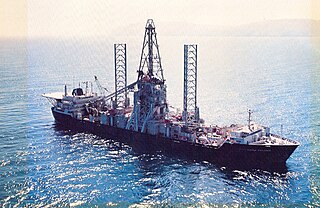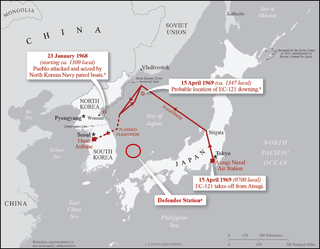Related Research Articles

The Los Angeles class of submarines are nuclear-powered fast attack submarines (SSN) in service with the United States Navy. Also known as the 688 class after the hull number of lead vessel USS Los Angeles (SSN-688), 62 were built from 1972 to 1996, the latter 23 to an improved 688i standard. As of 2022, 26 of the Los Angeles class remain in commission—more than any other class in the world—and they account for more than half of the U.S. Navy's 50 fast attack submarines.

The Sturgeon class was a class of nuclear-powered fast attack submarines (SSN) in service with the United States Navy from the 1960s until 2004. They were the "workhorses" of the Navy's attack submarine fleet throughout much of the Cold War. The boats were phased out in the 1990s and early 21st century, as their successors, the Los Angeles, followed by the Seawolf and Virginia-class boats, entered service.

The National Reconnaissance Office (NRO) is a member of the United States Intelligence Community and an agency of the United States Department of Defense which designs, builds, launches, and operates the reconnaissance satellites of the U.S. federal government, and provides satellite intelligence to several government agencies, particularly signals intelligence (SIGINT) to the NSA, imagery intelligence (IMINT) to the NGA, and measurement and signature intelligence (MASINT) to the DIA.

USS Richard B. Russell (SSN-687), a Sturgeon-class attack submarine, has been the only ship of the United States Navy to be named for Richard B. Russell, Jr. (1897–1971), United States Senator from Georgia (1933–1971).

USS Halibut (SSGN-587), a unique nuclear-powered guided missile submarine-turned-special operations platform, later redesignated as an attack submarine SSN-587, was the second ship of the United States Navy to be named after the halibut.

USS Scorpion (SSN-589) was a Skipjack-class nuclear-powered submarine that served in the United States Navy, and the sixth vessel, and second submarine, of the U.S. Navy to carry that name.

USS Parche (SSN-683), a Sturgeon-class submarine, was the second ship of the United States Navy to be named for the parche, a small, coral reef butterfly fish. Parche was launched on 13 January 1973, sponsored by Natalie Beshany, the wife of vice admiral Philip A. Beshany, and commissioned on 17 August 1974.

USS Grayling (SSN-646), a Sturgeon-class attack submarine, was the fifth ship of the United States Navy to be named for the grayling. Her keel was laid down in 1964, and she was launched just over three years later, and commissioned in 1969. She was involved in the submarine incident off Kola Peninsula on 20 March 1993, when she collided with the Russian Navy submarine Novomoskovsk. She was decommissioned in 1997, and disposed of a year later.

USS Alexandria (SSN-757), is a Los Angeles class nuclear-powered attack submarine and the third vessel of the United States Navy to be named for both Alexandria, Virginia, and Alexandria, Louisiana. The contract to build her was awarded to the Electric Boat Division of General Dynamics Corporation on 26 November 1984. Her keel was laid down in Groton, Connecticut, on 19 June 1987. She was launched on 23 June 1990, sponsored by Mrs. Myrtle "Tookie" Clark, wife of Vice Admiral Glenwood Clark (ret.), and commissioned on 29 June 1991. Alexandria was placed in service on 22 March 1991. A series of sea trials began 16 April and were completed 4 June.
John Piña Craven was an American scientist who was known for his involvement with Bayesian search theory and the recovery of lost objects at sea. He was Chief Scientist of the Special Projects Office of the United States Navy.

Project Azorian was a U.S. Central Intelligence Agency (CIA) project to recover the sunken Soviet submarine K-129 from the Pacific Ocean floor in 1974 using the purpose-built ship Hughes Glomar Explorer. The 1968 sinking of K-129 occurred approximately 1,600 miles (2,600 km) northwest of Hawaii. Project Azorian was one of the most complex, expensive, and secretive intelligence operations of the Cold War at a cost of about $800 million, or $4.7 billion today.

K-129 was a Project 629A diesel-electric-powered ballistic-missile submarine that served in the Pacific Fleet of the Soviet Navy–one of six Project 629 strategic ballistic-missile submarines assigned to the 15th Submarine Squadron based at Rybachiy Naval Base near Petropavlovsk, commanded by Rear Admiral Rudolf Golosov.

The submarine incident off Kildin Island was a collision between the US Navy nuclear submarine USS Baton Rouge and the Russian Navy nuclear submarine B-276 Kostroma near the Russian naval base of Severomorsk on 11 February 1992. The incident occurred while the US unit was engaged in a covert mission, apparently aimed at intercepting Russian military communications. Although most sources claim that the American submarine was trailing her Russian counterpart, some authors believe that neither Kostroma nor Baton Rouge had been able to locate each other before the collision.

Ola Tunander is a research professor emeritus at the Peace Research Institute Oslo. He worked as a researcher at PRIO in the period 1987-2016. He is the son of Museum Director Ingemar Tunander and his first wife Gunvor. Tunander is married to the Chinese scholar Yao Xiaoling. He has written and edited 12 books and a number of articles on security politics, naval strategy, submarine operations, geopolitics, dual state, psychological operations (PSYOP) and Cold War history.
Carl Ernest Duckett was the founder of the Central Intelligence Agency's science and technology operations.

Rufus Lackland Taylor Jr. was an officer in the United States Navy. Eventually he became Director of the Office of Naval Intelligence and held the rank of Vice Admiral. In 1966 he was appointed as Deputy Director of the Defense Intelligence Agency (DIA), then shortly thereafter as Deputy Director of the CIA, where he served from 1966 to 1969.

The submarine Incident off Kola Peninsula was a collision between the US Navy nuclear attack submarine USS Grayling and the Russian Navy nuclear ballistic missile submarine K-407 Novomoskovsk some 150 km (90 mi) north of the Russian naval base of Severomorsk, on 20 March 1993. The incident took place when the American submarine, who was trailing her Russian counterpart, lost track of Novomoskovsk. At the time that Grayling reacquired the other submarine, the short distance of only half-mile made the collision unavoidable. The incident happened just a week before the first summit between American president Bill Clinton and the president of the Russian Federation, Boris Yeltsin.
The 1982 Hårsfjärden incident was a peacetime naval engagement in which the Swedish Navy laid a trap for, pursued, and attempted to sink a foreign submarine that had violated Swedish territorial waters. The incident came in the wake of increased Soviet submarine activity in the Baltic Sea, with Sweden alleging that the Soviet Union had violated Sweden's territorial waters several times from 1974 – 1981. The incident, which led to a parliamentary investigation in Sweden, resulted in increased tensions between Sweden and the Soviet Union, and the claimed intrusion of a Soviet submarine remains a contested topic.

Operation Formation Star was the code name for the emergency re-deployment of U.S. Seventh Fleet warships to the Sea of Japan off the eastern coast of North Korea following that country's seizure of the USS Pueblo (AGER-2) in international waters on 23 January 1968.
References
- ↑ Jeffrey T. Richelson, The U.S. Intelligence Community (Cambridge Mass: Ballinger, 1989), pp. 26-29.
- ↑ Sherry Sontag & Christopher Drew with Annette Lawrence Drew. Blind Man's Bluff – The Untold Story of American Submarine Espionage (New York: HarperCollins, 1998), pp. 83, 164 and 206; Jeffrey T. Richelson, The Wizards of Langley: Inside the CIA's Directorate of Science and Technology (Boulder CO: Westview Press. 2001). Nigel West describe NURO as a joint "US Navy/CIA group" created "to coordinate and fund special projects conducted by submarines" in Nigel West, Historical Dictionary of International Intelligence – Historical Dictionary of Intelligence and Counterintelligence, No. 4 (Lanham, Maryland: Scarecrow, 2006).
- ↑ See below.
- ↑ Sontag & Drew (1998), pp. 81-82
- ↑ Sontag & Drew (1998), p. 83.
- ↑ Sontag & Drew (1998), pp. 83-84, 184-208.
- ↑ Sontag & Drew (1998), pp. 83, 164-167.
- ↑ John P. Craven, The Silent War – The Cold War Battle Beneath the Sea (New York: Simon & Schuster, 2001).
- ↑ Ola Tunander, The Secret War against Sweden – U.S. and British Submarine Deception in the 1980s (London: Frank Cass, 2004), pp. 259-261.
- ↑ Tunander (2004), pp. 254-255, 260-261.
- ↑ Interview with Caspar Weinberger, Sweden's TV2, 7 March 2000. Transcript of the interview is published in Tunander (2004), pp. 325-329.
- ↑ John McWethy, "World News Tonight", ABC (21 March 1984).
- ↑ Ola Tunander, Spelet under ytan [The Game beneath the Surface], Project Report 16, Sverige under det kalla kriget (SUKK) [Sweden during the Cold War] (Gothenburg Univ. & Stockholm Univ., 2007; 2009), p. 389.